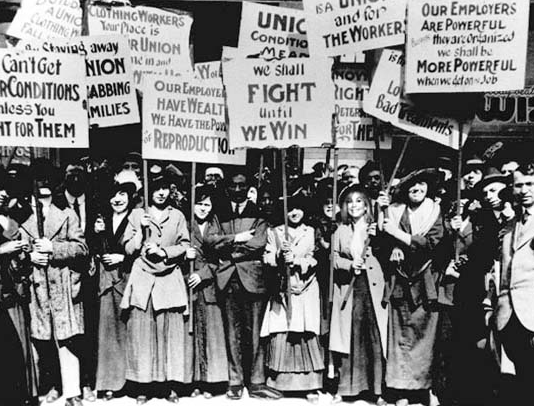Table of Contents
SUFFRAGISTS: FIGHTING FOR RIGHTS
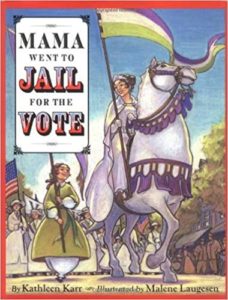
|
In Kathleen Karr’s Mama Went to Jail for the Vote (Hyperion, 2005), Susan Elizabeth’s suffragist mother is arrested for picketing the White House and ends up in jail. Activist Susan protests in turn, demanding her mother’s release – which she obtains, with a little help from President Wilson. For ages 4-8. |
| From Smithsonian Education, Winning the Vote for Women has a downloadable color-illustrated reading guide with activities to accompany the book. | |
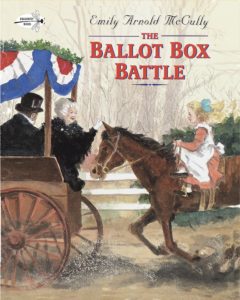
|
Emily Arnold McCully’s picture book The Ballot Box Battle (Dragonfly Books, 1998), set in 1880, centers around a determined little girl named Cordelia, her down-putting brother (“No votes for pea-brained females!”), and their indomitable next-door neighbor, Elizabeth Cady Stanton, who continues to try to cast her vote every year, despite the taunts of the local men. Appendices provide information about Stanton’s life, and instructions for making a ballot box and writing a “Kids’ Declaration of Rights.” For ages 5-8. |
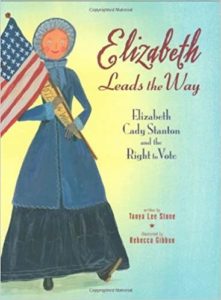
|
Tanya Lee Stone’s Elizabeth Leads the Way: Elizabeth Cady Stanton and the Right to Vote (Henry Holt and Company, 2008) is a picture-book biography with a brief catchy text. “What would you do if someone told you that you can’t be what you want to be because you’re a girl?” the book begins. “Would you talk back? Would you fight for your rights? Elizabeth did.” For ages 5-8. |
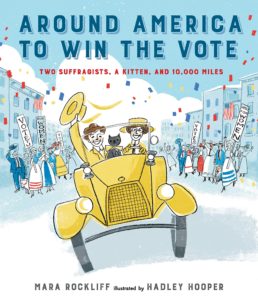 |
Mara Rockliff’s Around America to Win the Vote (Candlewick, 2016) is the story of Nell Richardson and Alice Burke who set off in 1916 to cross the country is a little yellow car promoting votes for women. (They took with them a sewing machine, a typewriter, and a kitten.) For ages 5-8. |
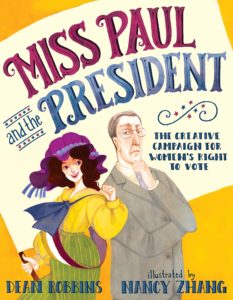 |
By Dean Robbins, Miss Paul and the President (Knopf, 2016) is the picture-book biography of activist Alice Paul, who confronted President Woodrow Wilson over the issue of women’s suffrage. For ages 5-8. |
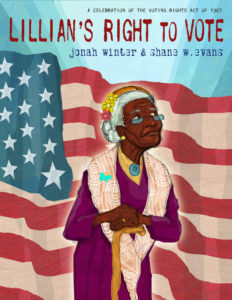 |
In Jonah Winter’s Lillian’s Right to Vote (Schwartz and Wade, 2015), a 100-year-old African-American woman, climbing the hill to the polling place, recalls her family’s history and the long struggle for voting rights in America. A brave and poignant story for ages 5-9. |
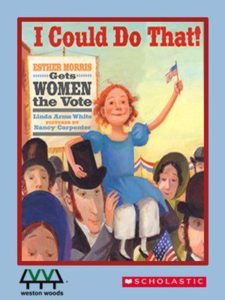
|
In Linda Arms White’s picture-book biography I Could Do That!: Esther Morris Gets Women the Vote (Farrar, Straus & Giroux, 2005), feisty Esther’s can-do philosophy – which starts at the age of six when she convinces her mother that yes, she can so make tea – eventually propels her to start her own business, help get women the vote in the Wyoming Territory, and become the first woman in the country elected to political office. For ages 5-8. |
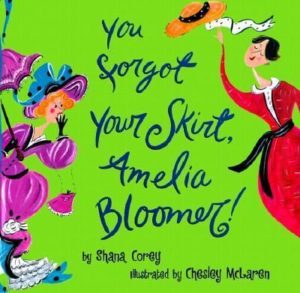
|
Shana Corey’s flamboyantly illustrated You Forgot Your Skirt, Amelia Bloomer! (Scholastic, 2000) is the story of Amelia Bloomer – “NOT a proper lady” – who revolutionized women’s restrictive 19th-century clothes by introducing the puffy pants that bear her name. (She also started her own newspaper and worked to get women the vote.) For ages 5-8. |
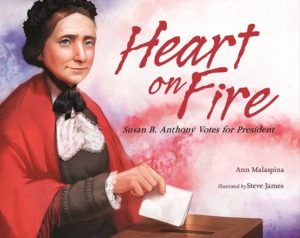
|
Ann Malaspina’s Heart on Fire: Susan B. Anthony Votes for President (Albert Whitman and Company, 2012) is a picture-book account of a landmark episode in Anthony’s life: the day in 1872 when she cast a ballot in a presidential election, was arrested, and – in spite of a convincing defense by Anthony – was convicted and fined. (She never paid.) The case effectively raised public awareness of the women’s suffrage movement. The book is written in free verse, with a compelling refrain of “Outrageous./Unbelievable./True.” For ages 5-9. |
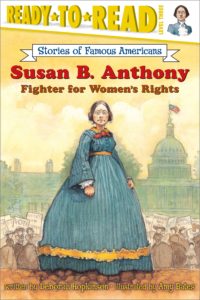
|
Deborah Hopkinson’s Susan B. Anthony: Fighter for Women’s Rights (Simon Spotlight, 2005) is a short chapter biography in the Ready-to-Read series. When Susan was born in 1820, Hopkinson begins “Married women couldn’t own land. Girls couldn’t go to college. No woman was allowed to vote.” Included is a timeline of Anthony’s life. For ages 6-9. |
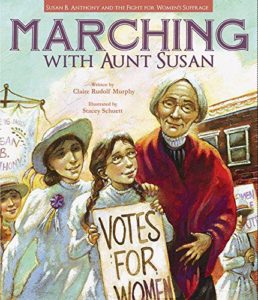
|
In Claire Rudolf Murphy’s Marching With Aunt Susan (Peachtree Publishers, 2011), ten-year-old Bessie, growing up in Berkeley, California, in 1896 – is beginning to discover that there are too many things girls aren’t allowed to do. Left behind when her father and brothers leave on a hiking expedition, Bessie meets Susan B. Anthony – called by all “Aunt Susan” – at a tea, and soon, along with her friend Rita, becomes a volunteer at the suffragists’ headquarters. Despite their efforts, California fails to give women the right to vote, but there’s hope for the future: at the end, Bessie is teaching her mother to ride a (liberating) bicycle and her father has agreed to take her hiking. Included is a supplementary resource list. For ages 6-9. |
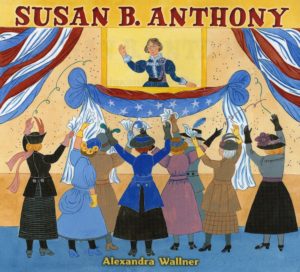
|
Alexandra Wallner’s Susan B. Anthony (Holiday House, 2012) is an attractive picture-book biography covering Anthony’s childhood and education, her passionate involvement in the women’s suffrage movement, and her friendship with fellow suffragist Elizabeth Cady Stanton. For ages 6-10. |
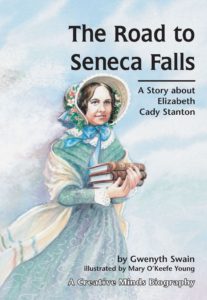 |
Gwyneth Swain’s The Road to Seneca Falls (First Avenue Editions, 1996) is a short chapter biography of Elizabeth Cady Stanton and her role in the first women’s rights convention, told in story form and illustrated with pencil drawings. For ages 7-9. |
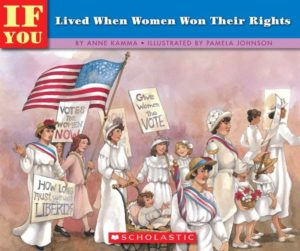
|
Anne Kamma’s If You Lived When Women Won Their Rights (Scholastic, 2006) is an overview of the women’s rights movement in America from the time of the first European settlers on. The book is written in a conversational question-and-answer format: “Which laws upset women most?” “What did women wear?” “Why weren’t women allowed to go to college?” “How did women earn money?” “What happened at the Seneca Falls Convention?” For ages 7-10. |
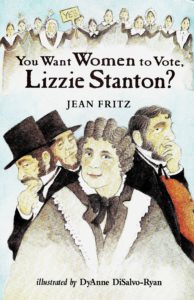 |
Jean Fritz’s You Want Women to Vote, Lizzie Stanton? (Putnam Juvenile Books, 1999) is a marvelous 96-page chapter biography of Elizabeth Cady Stanton, crammed with human interest, engaging details, and superbly presented history. For ages 8-12. |
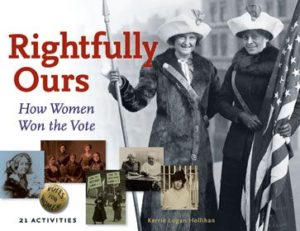
|
By Kerrie Logan Hollihan, Rightfully Ours: How Women Won the Vote (Chicago Review Press, 2012) is a terrific overview of the women’s suffrage movement, packed with wonderful period prints, cartoons, and photos, a timeline, a resource list, and 21 hands-on activities. These include making a coat-hanger banner and designing a pro-suffrage postcard, singing suffragist songs, experimenting with a “corset,” and trying some recipes from the Woman Suffrage Cook Book, written in 1886 to raise money for the cause. For ages 9 and up. |
| One of the projects in Rightfully Ours – “Make a Memory” – involves making a scrapbook, of the sort kept by Elizabeth Cady Stanton’s cousins, Elizabeth and Anne Miller, filled with mementos of the suffrage movement. For a webcast on the scrapbooks, digital images, and a wealth of information about women’s history, see Catch the Suffragists’ Spirit: The Millers’ Suffrage Scrapbooks from the Library of Congress. | |
| From ReadWriteThink, March is National Women’s History Month has a project for making a scrapbook of U.S. women’s history, with suggestions and recommended resources. | |
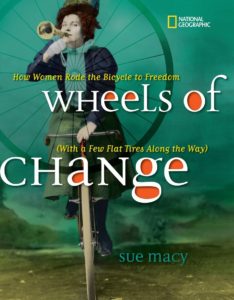
|
Sue Macy’s Wheels of Change (National Geographic Children’s Books, 2011), subtitled “How Women Rode the Bicycle to Freedom (With a Few Flat Tires Along the Way),” is a compelling account of how the bicycle contributed to women’s liberation, illustrated with terrific period photographs. For ages 10 and up. |
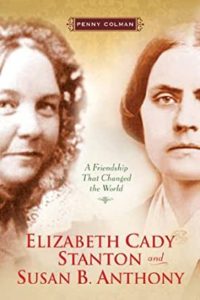
|
Penny Colman’s Elizabeth Cady Stanton and Susan B. Anthony: A Friendship That Changed the World (Henry Holt and Company, 2011) – filled with historical detail and human interest – is the story of the historic friendship between the two famous women’s rights activists who first met in Seneca Falls, NY, in 1851, three years after the first American women’s rights convention. For ages 12 and up. |
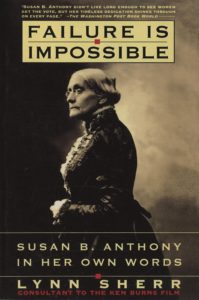 |
Lynn Sherr’s Failure Is Impossible: Susan B. Anthony in Her Own Words (Times Books, 1996) is a marvelous biography that interweaves historical narrative with excerpts from Anthony’s letters, articles, and speeches. A fascinating read that truly brings Anthony to life. For ages 13 and up. |
| From the National Archives Teaching With Documents collection, Failure Is Impossible is a Reader’s Theater script on the history of the suffrage movement. It calls for a narrator and three (or more) readers, who play the parts of fifteen historical figures. | |
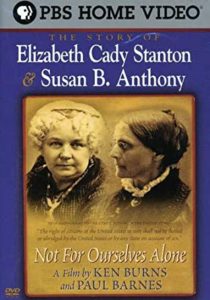 |
Directed by Ken Burns, PBS’s Not for Ourselves Alone covers the lives and work of Elizabeth Cady Stanton and Susan B. Anthony. The accompanying website has articles and essays, historical documents, a book list, links, and a wealth of information about women’s suffrage and the women’s movement today. |
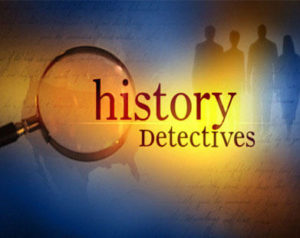 |
From PBS’s History Detectives, in which historical artifacts provide clues to historical events, Votes for Women is a collection of lesson plans and activities to accompany episodes (viewable online at the website) related to women’s history and issues: “Suffrage Pennant,” “Tiffany Glass,” and “Clara Barton.” |
